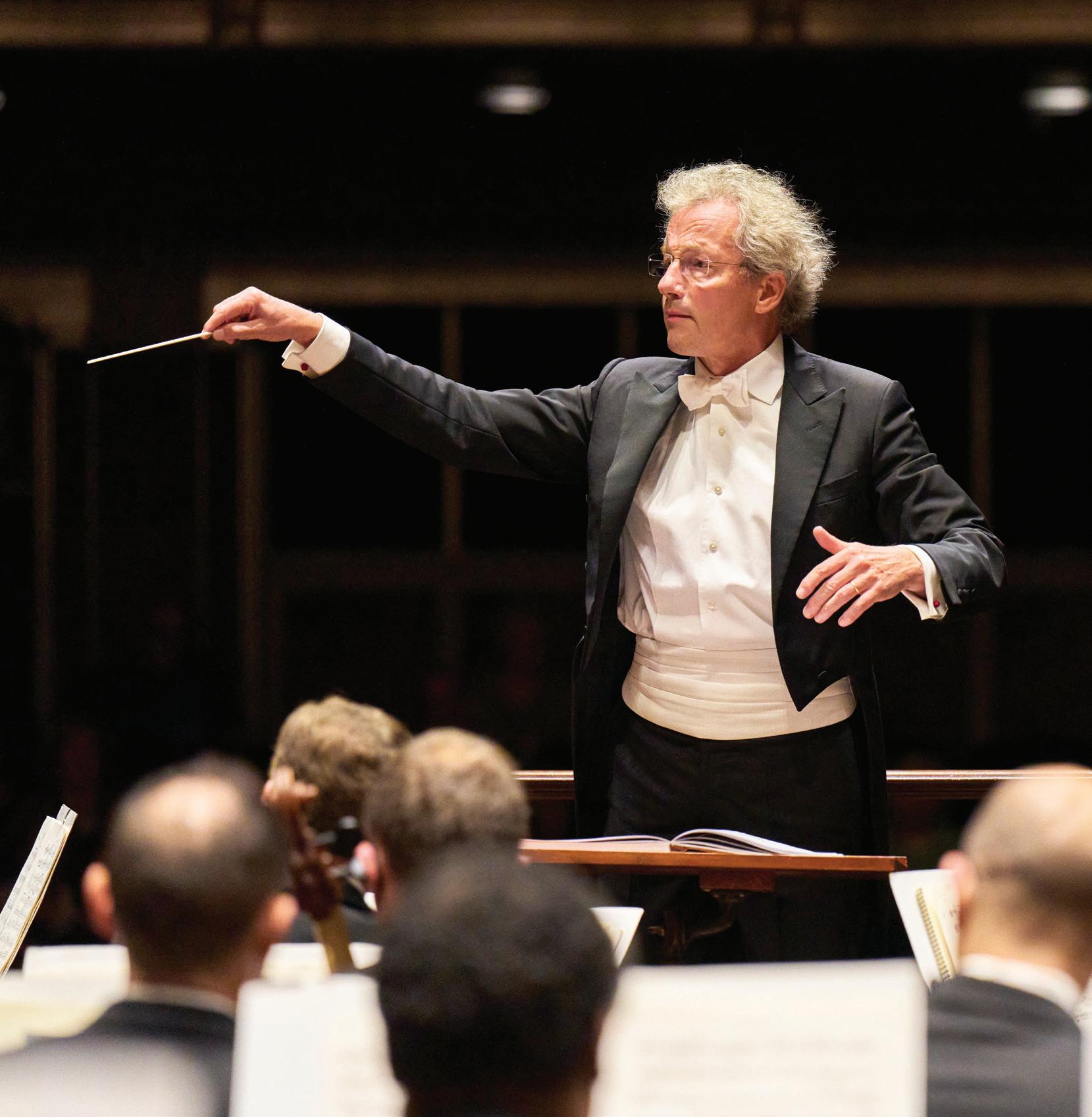
Mahler’s Resurrection 2022/2023 SEASON September 29–30, 2022
An award-winning journalist who has lived in Paris, Santa Fe, and New York City, he arrived in July 2020 via the suggestion of a fellow resident. He’s been delighted ever since.


“As a writer, I enjoy spending time alone, and these surroundings are perfect: my apartment is quiet, and the views overlooking the Cleveland Museum of Art are lovely. But by far the best part of Judson is the people.


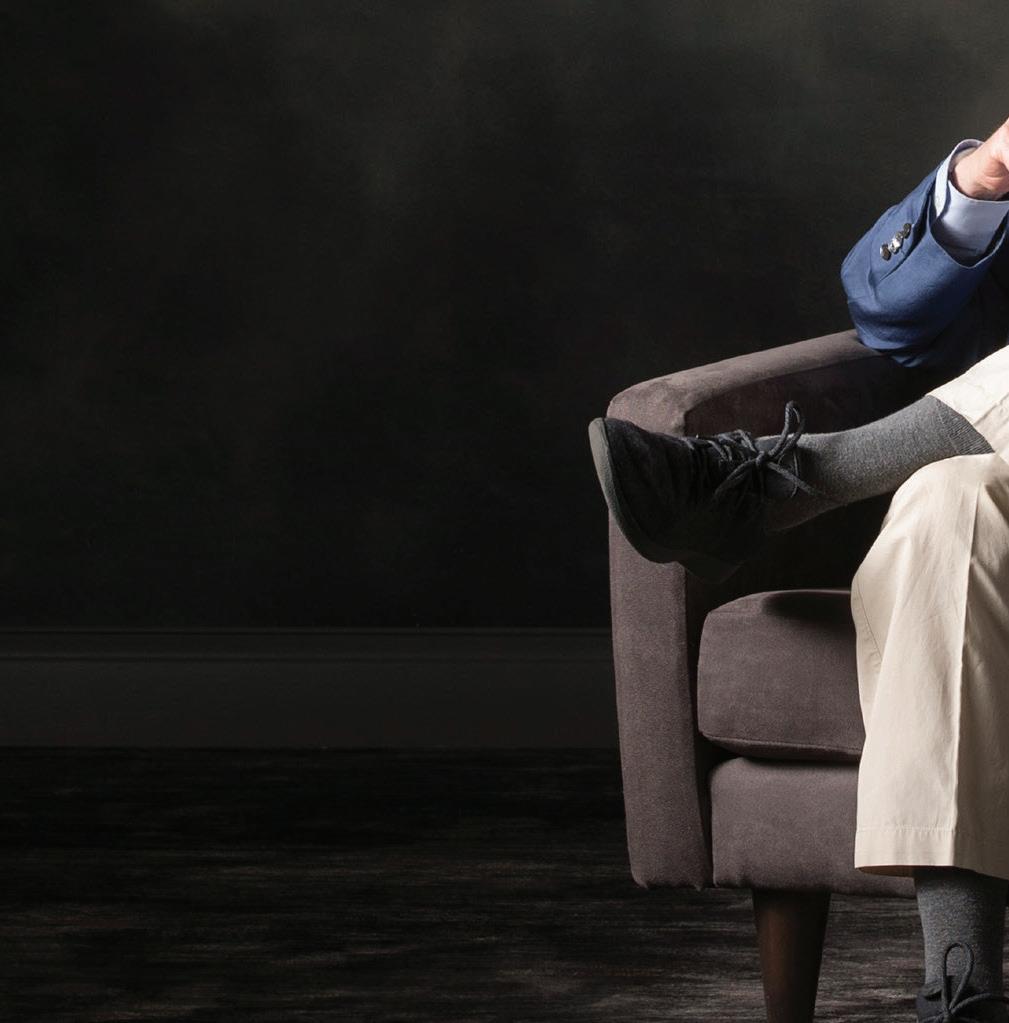
Everyone is so knowledgeable about art and culture. I wanted to have stimulating company to spend my time with, and I’ve found that here. These are wonderful, interesting people,” says Joe.
Read the full story at judsonsmartliving.org/blog
 Joe Coyle
Joe Coyle
Judson Park Cleveland Heights | Judson Manor University Circle | South Franklin Circle Chagrin Falls Learn more about how Judson can bring your retirement years to life! judsonsmartliving.org | 216.446.1579 “Expanding my curiosity about lifeis what it’s all about.” Completely engaged. That’s how Joe Coyle feels about his life at Judson Manor.
PHOTO BY ROGER
FROM
&

WELCOME TO THE OPENING CONCERTS of The Cleveland Orchestra’s 22/23 season, the 105th in our history! It’s always exhilarating to come back to Severance Music Center and our dedicated Northeast Ohio community, particularly following our first international tour in more than three years. There is truly no place like home.
The Orchestra’s return was greeted earlier this week by the announcement of Dr. Herbert G. Kloiber’s extremely generous gift of the autograph manuscript of Mahler’s Symphony No. 2 to the Orchestra. On behalf of the entire Cleveland Orchestra family, we are honored to be entrusted with this unique piece of the composer’s great legacy.
To mark this occasion, our season opens with Mahler’s “Resurrection” Symphony featuring Music Director Franz Welser-Möst leading the Orchestra, Chorus, and soloists in an incredible journey from death to life, guiding us to a vision of renewal fueled through faith in art and humanity.
It’s a remarkable start to a year filled with the promise of extraordinary musicmaking with old friends and new. Next month, conductor Thierry Fischer returns to Cleveland with a program highlighting the Norton Memorial Organ in Saint-Saëns’s Symphony No. 3. It’s followed by Nikolaj Szeps-Znaider conducting Beethoven’s Third Symphony, a profound exploration of both the heroic and destructive sides of war, as well as humanity’s ability to persevere throughout. Later this fall, our dear friend and frequent collaborator John Adams leads a performance of his oratorio El Niño, a modern-day retelling of the nativity story through the words of Latin American poetry.
At the same time, we welcome for the first time at Severance conductors Daniel Harding, Edward Gardner, and Thomas Søndergård; violinist Vilde Frang; and pianists Behzod Abduraimov and Víkingur Ólafsson, whose solo recital presages his Cleveland Orchestra debut in March.
The season culminates in May with the inaugural Jack, Joseph and Morton Mandel Opera and Humanities Festival, centered around three compelling performances of Puccini’s opera, The Girl of the Golden West, led by Franz Welser-Möst.
Mahler once said: “The symphony must be like the world. It must embrace everything.” The same can be said of each performance by The Cleveland Orchestra, which never fails to demonstrate the power of music to stimulate our thoughts and touch our hearts.
André Gremillet President & CEO

 PHOTO BY DON SNYDER
PHOTO BY DON SNYDER
clevelandorchestra.com
THE PRESIDENT
CEO THE CLEVELAND ORCHESTRACOVER:
MASTROIANNI | ABOVE:
THRIVING TOGETHER THROUGH MUSIC


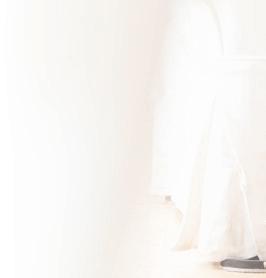





Proud to support The Cleveland Orchestra’s mission to inspire and enrich lives by creating extraordinary musical experiences. THRIVING TOGETHER THROUGH MUSIC



Proud to support The Cleveland Orchestra’s mission to inspire and enrich lives by creating extraordinary musical experiences.

2022/2023 SEASON
Mahler’s Resurrection
Thursday, September 29, 2022, at 7:30 p.m. Friday, September 30, 2022, at 7:30 p.m.
Franz Welser-Möst, conductor
Gustav Mahler (1860–1911)
Symphony No. 2 in C minor, (“Resurrection”)
I. Allegro maestoso
II. Andante moderato
III. Scherzo: In ruhig fliessender Bewegung (In quietly flowing motion)
IV. Urlicht (Primeval Light): Sehr feierlich, aber schlicht (Very solemn, but simple) —
V. Finale: Im Tempo des Scherzos. Wild herausfahrend. (In the tempo of the scherzo. Excitedly moving forward.) — Allegro energico — Der Grosse Appell (The Grand Summons) — Langsam, misterioso (Slow, mysteriously)
Lauren Snouffer, soprano Marie-Nicole Lemieux, contralto Cleveland Orchestra Chorus Lisa Wong, chorus director
These concerts will be performed without an intermission, with an approximate running time of 1 hour 20 minutes.
Thank you for silencing your electronic devices.
The Cleveland Orchestra acknowledges Dr. Herbert G. Kloiber with deep gratitude for his generous gift of the autograph manuscript of Gustav Mahler’s Symphony No. 2. This weekend’s concerts are sponsored by The J.M. Smucker Co.
JACK, JOSEPH AND MORTON MANDEL CONCERT HALL AT SEVERANCE MUSIC CENTER
THE CLEVELAND ORCHESTRA | 3clevelandorchestra.com
2022/2023 Season Sponsor
FROM THE MUSIC DIRECTOR
The Pursuit of the Profound
Willem Mengelberg who was a great friend and champion of Mahler’s. It had remained in the Mengelberg archives at the Netherlands Music Institute until it was purchased in 1984 by the American businessman and financial publisher Gilbert Kaplan, who spent much of his later years conducting the “Resurrection” Symphony around the world. Mr. Kaplan died in 2016, and the manuscript had been sold at auction for a record amount of money. Now it was at my side.
I think, for any musician, this is one of the most special moments you can experience in your life. To see the composer’s handwriting on the page, to discover where he emphasized something important, you feel so close to the creator and what he wrote.
Franz Welser-Möst, Music Director
A FEW YEARS AGO , I made plans to meet my good friend Herbert Kloiber at a café across from the Musikverein in central Vienna. What may have seemed like a casual coffee, was anything but. He arrived carrying a black briefcase, he set it on the floor, pushed it toward me, and said “take it home, and have a look.”
I immediately knew what was inside — the autograph manuscript of Mahler’s “Resurrection” Symphony, No. 2. This incredibly important document had been in Gustav Mahler’s possession when he died, then was passed to his wife Alma. She, in turn, gave it to the conductor
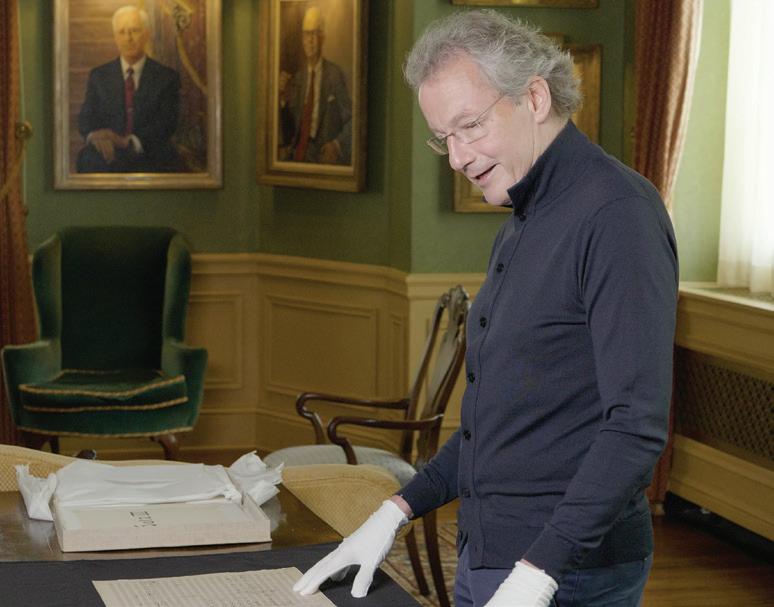
I was incredibly nervous taking the manuscript, something so precious both financially and culturally, back to my apartment in Vienna. I laid the briefcase on our dining room table — inside were two white gloves — I put them on and opened the first page. I think, for any musician, this is one of the most special moments you can experience in your life. To see the composer’s handwriting on the page, to discover where he emphasized something important, you feel so close to the creator and what he wrote. Nowadays, we are so used to email and texting, we forget how much someone’s handwriting can tell you about how a person thinks and what they value. Time shrinks.
Upon looking at the pages, two things immediately struck me. The first is the clarity of Mahler’s handwriting. You would think that someone who wrote such highly emotional music would reflect that excessiveness in his writing, but this is not the case. It tells you how
4 | 2022/2023 SEASON PHOTOS BY DIGITAL RIVER MEDIA
extremely well-thought through and meticulous he was. Even at the end of the Symphony, where the music reaches its most profound and impassioned moments, the clarity does not disappear in his handwriting.
The second is how many layers of corrections he made. Mahler is said to have told his disciples, “If, after my death, something doesn’t sound right, then change it. You have not only the right but you are obliged to change something if it serves the idea of the music.” Examining the changes he made, you can see he was very pragmatic.
left: Franz Welser-Möst examines the autograph manuscript of Mahler’s Second Symphony in Severance’s Ginn Suite. | above: Mahler’s handwriting shows just how meticulous and pragmatic he was as a composer.

As one of the most famous conductors of his time, he knew for whom he wrote and to what purpose. To see his process laid out clearly on a page, you feel as if you are in his presence.
* * *
The first time I saw a live performance of Mahler’s “Resurrection” Symphony, it was conducted by the manuscript’s previous owner, Gilbert Kaplan. He was leading a performance in London in the
THE CLEVELAND ORCHESTRA | 5clevelandorchestra.com
FROM THE MUSIC DIRECTOR
early 1980s, at the same time that I was in the city for a month to improve my English. My teacher, knowing that I was a musician but also a student with little money to spend on expensive concert tickets, took me to a performance.
It’s hard to describe the experience I had during that concert; the Symphony itself is somewhat too big to take in over one sitting. But that sense of bigness pervades much of Mahler’s music, especially his symphonies, in which he takes aim at nothing less than the essence of human existence — Mahler famously said that a symphony should “embrace everything.” In the Second Symphony, nicknamed the “Resurrection,” he accomplishes this through the central idea of life after death.
* * *
The first time I conducted the Second Symphony was with the Residentie Orchestra of The Hague in my hometown of Linz, Austria. The performance took place in the New Cathedral, the largest Roman Catholic cathedral in Austria, surrounded by religious iconography and a solemn ambiance. It was a beautiful setting but one that presented some acoustical challenges with eight seconds of resonance — everything was swimming too much in the space. It was muddy.
I’ve since conducted the “Resurrection” Symphony several times, and each time I come back to it with a fresh approach. This is a big piece that sets out on a grand journey. The first movement was originally conceived as a separate symphonic poem called Totenfeier,
which means “The Celebration of the Dead.” Mahler marked this movement Allegro maestoso, or lively, but it’s often referred to and played as a funeral march. And thus, we must make a decision: Is the music illustrating our angst and fear of death? Or is it about observing the reality of death? Some people may say we are splitting hairs with these questions, but we’re not. They are fundamental and provide a foundation for the entire work. A symphony is like an architectural structure that is held together in a fine balance. The first movement provides the base for the structure — without this solid footing, there is nowhere to go.
There are moments I enjoy enormously, when I can take a little time to admire the beauty of the music. For example, the second movement, based on an Austrian Ländler folk dance, demonstrates the influence of the landscape and nature on Mahler’s music. I’m very fortunate to live across the lake from the cabin where Mahler composed the Second Symphony, and I’ve hiked many of the trails that he once walked. You can almost smell the Austrian countryside when you hear this music.
Then there are passages that are otherworldly in their magnificence, culminating in the fifth and final movement when Mahler draws upon the texts of Friedrich Gottlieb Klopstock’s poem, “Die Auferstehung” (“The Resurrection”), which says in essence, “Yes, I believe in resurrection, and God is going to grant that to me.” It’s accompanied by the most powerful musical language depicting
6 | 2022/2023 SEASON
an ascent toward heaven, the glory of God, and a world illuminated by love. You would be a block of ice if it did not resonate with you.
The Second Symphony is almost sacred in this way, but the image that Mahler presents is broader than just a religious vision; it encompasses a universal spirituality that touches the core of our humanity. And that’s what a great work of art provides: the space to reflect on our own lives, the communi ties where we live, our relationships, and what we’ve experienced both personally and in the larger world.
As I prepare for The Cleveland Orchestra’s performances on September 29 and 30, I wonder, what does the idea of “Resurrection” mean to us now compared to five years ago? We play the same notes on the page, but maybe there’s a shift within ourselves. It could be because of the war in Ukraine, the pandemic, or the loss of a loved one. Maybe because of these events, we are more afraid of death than we were in 2018, the last time the Orchestra performed this Symphony at Severance.
Mahler had an unwavering belief in art’s ability to draw out the divine from within us, and that is an inspiring notion, especially during uncertain times. I think one of the reasons that Mahler’s music still speaks to us is his continual search for the essence of what makes us human as individuals and collectively. While this glorious Symphony speaks to each of us personally, it cannot be realized without the collaboration of nearly 200
musicians all working together toward a common purpose. You can see Mahler’s pursuit of these lofty goals in the handwritten markings using different colored inks, continually refining his musical ideas to make them clearer, more potent, more profound.
— Franz Welser-Möst
SEE MAHLER’S MANUSCRIPT


Take in the beauty of Mahler’s handwriting yourself. The autograph manuscript of the Second Symphony will be on view in the Grand Foyer before and immediately following the concerts on September 29 & 30.
The Cleveland Orchestra thanks the Cleveland Museum of Art for their partnership in the display and care of the Mahler Symphony No. 2 manuscript.
PHOTO
ART
THE CLEVELAND ORCHESTRA | 7clevelandorchestra.com
COURTESY OF THE CLEVELAND MUSEUM OF
Thank you, supporters!
Your ongoing generosity brings the magic to our stage. We are so delighted to welcome you back to Severance for another beautiful season!
Thank you for making the 2022/23 Classical Season possible. You keep the music playing, and we are so grateful.

To learn more and join the Orchestra’s donor family, visit: clevelandorchestra.com/give
Scan me!
Symphony No. 2 in C minor (“Resurrection”)
By Gustav Mahler
BORN : July 7, 1860, in Kalischt, Bohemia (now Kalište in the Czech Republic)
DIED : May 18, 1911, in Vienna, Austria
Ω
Ω
Ω
COMPOSED : 1888–94
WORLD PREMIERE : December 13, 1895, with the Berlin Philharmonic conducted by Mahler.
CLEVELAND ORCHESTRA PREMIERE : January 1936 at Severance Hall, conducted by Artur Rodziński. It was most recently performed in Cleveland and Miami during the 2018/19 season with Music Director Franz Welser-Möst leading all performances.
Ω
ORCHESTRATION : 4 flutes (all doubling piccolo), 4 oboes (3rd and 4th doubling english horn), 3 clarinets (3rd doubling bass clarinet), 2 E-flat clarinets, 4 bassoons (3rd and 4th doubling contrabassoon), 10 horns, 6 trumpets, 4 trombones, tuba, 2 sets of timpani, percussion (snare drums, bass drum, cymbals, 2 tam-tams, triangle, glockenspiel, 3 bells, rute [a bundle of twigs or a birch-broom]), 2 harps, organ, and strings, plus soprano and alto soloists, and mixed chorus
DURATION : 1 hour 20 minutes
ECSTATICALLY INTONED by the chorus, these optimistic lines of Mahler’s own poetry conclude his “Resurrection” Symphony, the second of his symphonic worlds. Its prolonged six-year genesis was perhaps the most crucial episode in his career: the Second would put Mahler the composer permanently on the musical map of Europe. Mahler was already establishing himself as a notable conductor of opera in Leipzig when he composed his Second

shall die in order to live!
yes arise, you shall, my heart, in just a moment.
you have borne will bear you to God!
THE CLEVELAND ORCHESTRA | 9clevelandorchestra.com THE MUSIC
Ω
I
Arise,
What
THE MUSIC
Symphony, which opens the 2022/23 Cleveland Orchestra season. The circumstances were as follows: In January 1888, he premiered his own completion of Carl Maria von Weber’s unfinished opera Die drei Pintos, which drew widespread acclaim. Weber’s sketches for Pintos had been entrusted to him by the composer’s grandson, with whose wife, Marion, Mahler became involved in a passionate affair. As Mahler later recounted, Marion’s “musical, luminous being of highest aspiration… gave my life a new and deepest meaning, albeit later disastrous for us both.” That plus the heady success of Die drei Pintos inspired Mahler to compose at white-hot speed. The “Blumine” Andante of the First Symphony (later suppressed) was conceived as a birthday gift for Marion; however, two other movements of the First quote extensively from Mahler’s Songs of a Wayfarer, a cycle of four lieder based on his own texts about unrequited love and suicide. Not surprisingly, the conductor Bruno Walter, Mahler’s friend and disciple of many years, would later dub the First Symphony “Mahler’s Werther,” alluding to Goethe’s famous epistolary novel of a tragic love triangle. But even before he penned the triumphant conclusion of that work, Mahler had launched its dark counter part in the grim C-minor funeral march that would become the cornerstone of his Second Symphony. While working on it amidst the floral trophies he had received at the Pintos premiere, he was suddenly seized by a vision of himself
dead on a bier, bedecked with the flowers and wreaths — which Marion von Weber had to remove for him. Mahler completed a draft of this movement and made a few sketches for the following one, but was unable to proceed further. A position in Prague took him away from Marion and Leipzig, and by September 1888, he was soliciting performances of the funeral march, now (or soon to be) entitled “Todtenfeier” (“Celebration of the Dead”), before he had any notion of how to finish the Second Symphony.
Todtenfeier was the title that had recently been used by Mahler’s close friend and mentor, Siegfried Lipiner, for his 1887 German translation of Polish poet Adam Mickiewicz’s dramatic epic Dziady. One portion of the poem seems
 PHOTO:
PHOTO
Marion Mathilde von Weber-Schwabe (1856–1931) was married to Karl von Weber, grandson of the composer, when she began an affair with Gustav Mahler
PHOTO:
PHOTO
Marion Mathilde von Weber-Schwabe (1856–1931) was married to Karl von Weber, grandson of the composer, when she began an affair with Gustav Mahler
10 | 2022/2023 SEASON
ALBUM / ALAMY STOCK
suspiciously close to Mahler’s own circumstances in 1888: It is the tale of a love triangle, based on Werther, whose principal characters are named Gustav and Marie. The tragic denouement is Gustav’s suicide, followed by the realization that he has been transformed into a wandering spirit condemned to hover in the vicinity of his beloved. As in the First Symphony, Mahler incorporates notable allusions to his Songs of a Wayfarer into “Todtenfeier”: Both its main theme and the gnashingly dissonant fortissimo climax just before the recapitulation are derived from the explicitly suicidal third song of the Wayfarer cycle, “Ich hab’ ein glühend Messer” (“I Have a Burning Knife in My Breast”). And he also quotes the Dies irae (Day of Wrath) chant that was sung at every requiem Mass until the mid-20th century.
Since their student days, both Mahler and Lipiner had embraced a view of tragic art and its redemptive power derived from the philosophical writings of Schopenhauer, Wagner, and Nietzsche. According to this viewpoint, defiant heroism such as that of Prometheus, who stole fire from the gods and gave it to humankind, necessarily leads towards self-transcendence and redemption. That is the overriding theme of the “Resurrection” Symphony as a whole, triumphantly celebrated in its conclusion. The musical rhetoric of “Todtenfeier” inaugurating this vast musical epic conveys far greater anguish than do Mahler’s veiled comments about it, such as his oft-cited program note of 1901:
We are standing at the coffin of a beloved person. His life, struggles, sorrows, and ambition will pass once again, for the last time, before the eye of our soul.... What now?... Is all this only a desolate dream, or do this life and this death have some sense? And we must answer this question if we are to go on living.
By 1901, determined not to become mired in the polemical debates between Brahmsians and Wagnerians, Mahler had largely forsworn programmatic commentary about his music. He believed his works would succeed without such verbal appendages, and history has certainly proven him right. Nevertheless, a full century later, scholars and critics have come to realize that if not taken too literally, Mahler’s metaphorical remarks about his early symphonies can enhance our access to the contexts surrounding them and the musical imagery within them.
The deaths of both his parents and one of his sisters, new conducting posts in Budapest and Hamburg, the failure of the First Symphony, and lack of inspiration brought Mahler’s creative work to a halt for four years following “Todtenfeier.” Then, in January 1892, he turned again to Des Knaben Wunderhorn (From the youth’s magic horn), the early19th-century collection of folk poetry he first encountered at Marion von Weber’s: the extraordinary result was “Das himmlische Leben” (“Heavenly Life”), ultimately the finale of Mahler’s Fourth Symphony, and the earliest of the
THE CLEVELAND ORCHESTRA | 11clevelandorchestra.com
childlike yet sophisticated orchestral songs that would find their way into his next three symphonies. He finally resumed work on the Second in the summer of 1893, completing the Andante moderato and Scherzo. Mahler subse quently told his confidante Natalie Bauer-Lechner that both movements were “episodes from the life of the departed hero,” and that “the Andante concerns love.” The Scherzo, however, is based largely on another Wunderhorn song composed almost simultaneously with it, “Des Antonius von Padua Fischpredigt” (“Saint Anthony of
Padua’s Fish Sermon”). Mahler charac terized the “Fish Sermon” as “my satire on mankind”: the swirling underwater congregation listens and swims away “not an iota wiser, even though the holy one has performed for them!” In transforming lied into scherzo, Mahler opens with a solo for timpani, intensifies the song’s contrasts and orchestration, adds a rather idyllic trio section dominated by a solo trumpet, and near the end interpolates a “fearful scream” foreshadowing the onset of the Finale. He summed up the results with a visual comparison:

12 | 2022/2023 SEASON
THE MUSIC
...when you look at a dance from afar through a window, but are unable to hear the music, the turning and commotion of the couple seem absurd and pointless.... Likewise, to someone who has lost himself and his happiness, the world seems crazy and confused.
(It is noteworthy that precisely such a scene occurs just prior to Gustav’s suicide in Mickiewicz’s Todtenfeier.)
Yet the problem of the Finale re mained. The famous “lightning bolt” of inspiration struck Mahler at the funeral ceremony (“Todten-Feier,” the bulletin at the time read) of the renowned conductor Hans von Bülow on March 29, 1874. Not coincidentally so, according to the psychoanalyst Theodor Reik: in 1891, Mahler had played his “Todtenfeier” movement on the piano for Bülow, hoping he would perform it. But Bülow had covered his ears and declared that if this was music, he no longer knew what music was. Thus, at Bülow’s funeral Mahler’s creative logjam may have been broken up by subconscious emotional triumph over the harsh authoritarian master. In any case, the sound of the boys’ choir singing Klopstock’s hymn “Aufer stehen” (“Resurrection”) in Hamburg’s St. Michael’s Church ignited Mahler’s creativity, and he moved quickly.

Adopting two stanzas of the Klopstock text, he wrote six more of his own and
determined that his earlier Wunderhorn song “Urlicht” (“Primeval Light”) would serve marvelously as a miniature prelude to his emerging vision of Doomsday. By June 29, 1894, three weeks into his summer holiday, he had drafted the Second Symphony’s extraordinary conclusion scored for chorus, soloists, and a very large orchestra.
The events of the Finale that Mahler described to Bauer-Lechner, some of which are also marked in the autograph score, can be readily identified in the music:
It begins with the terrifying scream of the scherzo. And now the solution of the frightening question of life.... Terrifying quaking runs over the earth.... The Great Roll Call sounds: the graves spring open and all creatures struggle forth from the earth moaning and chattering their teeth. Now they all come marching forth in a powerful procession: rich and poor, peasants and kings, the army of the church, the popes. Among all is the same anguish, screaming, and trembling, because none is justified before God. In the meanwhile once more — as though from the other world — the Roll Call sounds again. Finally, after the most awful confusion, they are silent, and only the sound of the bird of death, far away, from the last grave, is heard, and finally it dies away.— And now comes nothing of what all expected; no divine judgment, no blessed and no damned; no good, no evil ones, no judge! All of that has ceased to exist. And softly and simply swells forth:
Gustav Mahler captured at work in Rome in 1907. He was in the city performing with the Orchestra di Santa Cecilia.
THE CLEVELAND ORCHESTRA | 13clevelandorchestra.comPHOTO: LEBRECHT MUSIC & ARTS / ALAMY STOCK PHOTO
“Arise, yes, arise...,” to which the words themselves are sufficient commentary.

This is, of course, not the traditional Christian vision of resurrection, but one based on Faustian striving, self-transcen dence, and belief in universal salvation — all of which had been tenets of Mahler’s and Lipiner’s worldview for nearly 20 years.
Suffering from a severe migraine, the composer himself stoically conduct ed the premiere of the work on Decem ber 13, 1895, having hired the Berlin Philharmonic at his own expense. He had, as Bruno Walter puts it, “staked his future fate as a composer upon a single
card” — and he won. The critics would prove almost unanimous in their scorn, but the audience’s enthusiasm grew steadily throughout the performance; there were tears and gasps at the hushed moment of the choral entrance, and heartfelt ovations following the jubilant conclusion. As Walter also notes, Mahler’s ascendancy as a composer can justly be dated from that evening; henceforth, only he and Richard Strauss would be regarded by connoisseurs as the foremost modern German composers.
— Stephen E. Hefling
Stephen E. Hefling is a professor emeritus at Case Western Reserve University. He is widely regarded as America’s leading Mahler specialist.
27100
(216)
LJI builds confidence in every customer and ensures quality repairs and superior customer service. Our commitment is to achieve and retain customer loyalty for life!
1640 Lee Rd. at Mayfield Cleveland Hts. (216) 932-7100
LJI builds confidence in every customer and ensures quality repairs and superior customer service. Our commitment is to achieve and retain customer loyalty for life!

27100 Chagrin Blvd. at I-271
1640 Lee Rd. at Mayfield NOW TWO LOCATIONS

Chagrin Blvd. at I-271 Orange Village
364-7100
TWO LOCATIONS Customer Confidence – Priority One™ ljicollisioncenter.com Customer Confidence – Priority One™ Lauren Angie Jill Strauss team is fourth generation in the industry mission locations
THE MUSIC



™ our mission locations 34300 Solon Road | Solon, OH | 440-248-2424 | 800-260-2949 One block south of Rt. 422 & SOM Center Road 9-9 M/Th | 9-5:30 Tu/W/F/Sa | www.sedlakinteriors.com Complimentary Delivery and Set-Up Within 60 Miles. Experience the largest collection of upholstered, leather and motion furniture in Northeast Ohio. Need a More Comfortable Seat? CELEBRATING
THE SUNG TEXTS
Symphony No. 2 in C minor (“Resurrection”)
Movement IV: Urlicht (Primeval Light) text adapted by Gustav Mahler from Des Knaben Wunderhorn (From the youth’s magic horn) as collected and adapted by Achim von Arnim and Clemens Brentano
ALTO SOLOIST
O Röschen rot!
Der Mensch liegt in grösster Not!
Der Mensch liegt in grösster Pein!
Je lieber möcht’ ich im Himmel sein!
Da kam ich auf einen breiten Weg, Da kam ein Engelein und wollt’ mich abweisen.
Ach nein! Ich liess mich nicht abweisen!
Ich bin von Gott und will wieder zu Gott!
Der liebe Gott wird mir ein Lichtchen geben, Wird leuchten mir bis in das ewig selig Leben!
O tiny red rose!
Humanity lies in greatest need! Humanity lies in greatest pain!
I would much rather be in Heaven!
Once I came onto a broad path, and an angel came and wanted to turn me away. But no, I would not be turned away! I am from God and would return to God! Dear God will give me a light, Which will light my way to eternal, blissful life!
Movement V: Finale: Auferstehung (“Resurrection”) text by Friedrich Klopstock (1724–1803) as adapted and extended by Mahler
CHORUS & SOPRANO SOLOIST
Aufersteh’n, ja, aufersteh’n wirst du, Mein Staub, nach kurzer Ruh!
Unsterblich Leben! Unsterblich Leben Wird der dich rief dir geben!
Wieder aufzublüh’n wirst du gesät!
Der Herr der Ernte geht Und sammelt Garben Uns ein, die starben!
Rise again, yes, you will rise again, my dust, after a brief rest! Immortal life! Immortal life will be granted by the One who calls you!
To bloom again you were sown! The Lord of the Harvest goes forth and gathers like sheaves, those of us who have died!
16 | 2022/2023 SEASON
ALTO SOLOIST
O glaube, mein Herz, o glaube:
Es geht dir nichts verloren!
Dein ist, Dein, ja Dein, was du gesehnt!
Dein, was du geliebt!
Was du gestritten!
SOPRANO SOLOIST
O glaube:
Du wards nicht umsonst geboren!
Hast nicht umsonst gelebt, gelitten!
CHORUS & SOLOISTS
Was entstanden ist, das muss vergehen!
Was vergangen, auferstehen!
Hör’ auf zu beben!
Bereite dich zu leben!
SOPRANO & ALTO SOLOISTS
O Schmerz! Du Alldurchdringer!
Dir bin ich entrungen!
O Tod! Du Allbezwinger!
Nun bist du bezwungen!
Mit Flügeln, die ich mir errungen, In heissem Liebesstreben
Werd’ ich entschweben
Zum Licht, zu dem kein Aug’ gedrungen!
CHORUS & SOLOISTS
Mit Flügeln, die ich mir errungen, In heissem Liebesstreben
Werd’ ich entschweben
Zum Licht, zu dem kein Aug’ gedrungen! Sterben werd’ ich, um zu leben!
Aufersteh’n, ja, aufersteh’n wirst du, Mein Herz, in einem Nu!
Was du geschlagen, Zu Gott wird es dich tragen!
O believe, my heart, O believe: nothing will be lost to you!
Yours is… yours… yes, yours is what you longed for! Yours is what you loved, what you fought for!
O believe!
You were not born in vain! You have not lived in vain, nor suffered!
What has come into being, must perish! What has perished must rise again! Cease from trembling! Prepare to live!
O Pain, you who pierce all things, from you I have been taken!
O Death, conqueror of all things, now you are conquered!
With the wings I have won for myself, in love’s ardent struggle, I shall fly upward to that light which no eye has penetrated!
With wings I won for myself, in love’s ardent struggle, I shall fly upward to that light which no eye has yet seen! I shall die so as to live!
Rise again, yes, you will rise again, My heart, in an instant! Your own beating will take you to God!
THE CLEVELAND ORCHESTRA | 17clevelandorchestra.com

Franz Welser-Möst, Music Director kelvin smith family chair
In addition to his commitment to Cleveland, Mr. Welser-Möst enjoys a particularly close and productive relationship with the Vienna Philharmonic as a guest conductor. He has been invited to conduct its celebrated New Year’s Concert three times, and regularly leads the orchestra at home in Vienna, as well as on tours.

FRANZ WELSER-MÖST IS AMONG today’s most distinguished conductors. The 2022/23 season marks his 21st year as Music Director of The Cleveland Orches tra. With the future of their acclaimed partnership extended to 2027, he will be the longest-serving musical leader in the ensemble’s history. The New York Times has declared Cleveland under WelserMöst’s direction to be “America’s most brilliant orchestra,” praising its virtuosity, elegance of sound, variety of color, and chamber-like musical cohesion.
With Mr. Welser-Möst, The Cleveland Orchestra has been praised for its inventive programming, ongoing support of new music, and innovative work in presenting operas. To date, the Orchestra and Mr. Welser-Möst have been show cased around the world in 20 international tours together. In 2020, the ensemble launched its own recording label and new streaming broadcast platform to share its artistry globally.
Mr. Welser-Möst is also a regular guest at the Salzburg Festival where he has led a series of acclaimed opera productions, including Rusalka, Der Rosenkavalier, Fidelio, Die Liebe der Danae, Aribert Reimann’s opera Lear, and Richard Strauss’s Salome. In 2020, he conducted Strauss’s Elektra on the 100th anniversary of its premiere. He has since returned to Salzburg to conduct addi tional performances of Elektra in 2021 and Giacomo Puccini’s Il Trittico in 2022.
In 2019, Mr. Welser-Möst was awarded the Gold Medal in the Arts by the Kennedy Center International Committee on the Arts. Other honors include The Cleveland Orchestra’s Distinguished Service Award, two Cleveland Arts Prize citations, the Vienna Philharmonic’s “Ring of Honor,” recognition from the Western Law Center for Disability Rights, honorary membership in the Vienna Singverein, appointment as an Academi cian of the European Academy of Yuste, and the Kilenyi Medal from the Bruckner Society of America.
 PHOTO
PHOTO
THE CLEVELAND ORCHESTRA | 19clevelandorchestra.comABOVE:
BY MARCO BORGGREVE THE CONDUCTOR
THE ARTISTS
RECOGNIZED FOR HER ARTISTIC curiosity spanning the music of the Baroque to contemporary composers, American Lauren Snouffer is one of the most versatile and respected sopranos on the international stage.
During the 2022/23 season, Ms. Snouffer joins The Cleveland Orchestra for performances of Mahler’s Symphony No. 2 and El Niño. She also performs Mozart’s Mass in C minor (Pittsburgh Symphony), Handel’s Jeptha (Music of the Baroque), Handel’s Messiah (San Francisco Symphony), Bach’s Mass in G Major (Handel & Haydn Society), Beethoven’s Symphony No. 9 (New York Philharmonic), and Hans Abrahamsen’s Let Me Tell You (NDR Elbphilharmonie Orchester). Operatic performance include Die Zauberflöte (Opernhaus Zürich), Le nozze di Figaro (Houston Grand Opera), Il barbiere di Siviglia (Austin Opera), Monteverdi’s Orfeo (Santa Fe Opera), and Xerxes (Detroit Opera).
Ms. Snouffer is an eminent interpreter of contemporary music, having debuted at the Opéra national du Rhin in Abrahamsen’s The Snow Queen. She also sang in the world premieres of Girl with a Pearl Earring by composer Stefan Wirth, The Phoenix by composer Tarik O’Regan and librettist John Caird, and The House Without a Christmas Tree by Ricky Ian Gordon and Royce Vavrek.
Past seasons include performances of Le nozze di Figaro at Houston Grand
Opera; Rusalka, La clemenza di Tito, and Orphée et Eurydice (directed and choreographed by John Neumeier under the baton of Harry Bicket) at Lyric Opera of Chicago; Le comte Ory and Die Zauberflöte at Seattle Opera; Handel’s Aci, Galatea, e Polifemo with Philharmonia Baroque Orchestra; and Hasse’s Siroe at the Opéra Royal de Versailles, with additional performances in Budapest and Vienna.
An alumna of the Houston Grand Opera Studio, Ms. Snouffer graduated from Rice University and The Juilliard School.
 PHOTO
Lauren Snouffer, soprano
PHOTO
Lauren Snouffer, soprano
20 | 2022/2023 SEASON
COURTESY LAUREN SNOUFFER
Marie-Nicole Lemieux, contralto
MARIE-NICOLE LEMIEUX’S powerful voice, her superb sense of line, and a faultless virtuosity, as well as her sense of nuance and drama, is suited to a range of repertoire: from Gluck and Handel to Berlioz and Bizet to Rossini and Verdi.

She launched her international career that has led her to the world’s most famous stages with a 2000 win of the Queen Fabiola and Lied Prize at the Queen Elisabeth Competition in Belgium.
Since then, she has performed at Teatro alla Scala, Royal Opera House (Covent Garden), Paris National Opera, Théâtre des Champs-Elysées, Théâtre du Capitole in Toulouse, La Monnaie in Brussels, Berlin’s Staatsoper, Opernhaus Zürich, Theater an der Wien, Teatro Real in Madrid, Gran Teatre del Liceu in Barcelona, Salzburg Festival, Glyndebourne Festival, Chorégies d’Orange, Canadian Opera Company in Toronto, Montreal Opera, and others.
In addition to her career in opera, Ms. Lemieux is a regular guest of orchestras, including The Cleveland Orchestra, New York Philharmonic, Los Angeles Philharmonic, Montreal Symphony Orchestra, Orchestre Métropolitain, Orchestre Symphonique de Québec, Les Violons du Roy, Deutsches Symphonie-Orchester Berlin, Orchestra dell’Accademia Santa Cecilia, London Philharmonia, Rotterdam Philharmonic Orchestra, Orchestre Philharmonique de Radio-France, and Orchestre National de France.
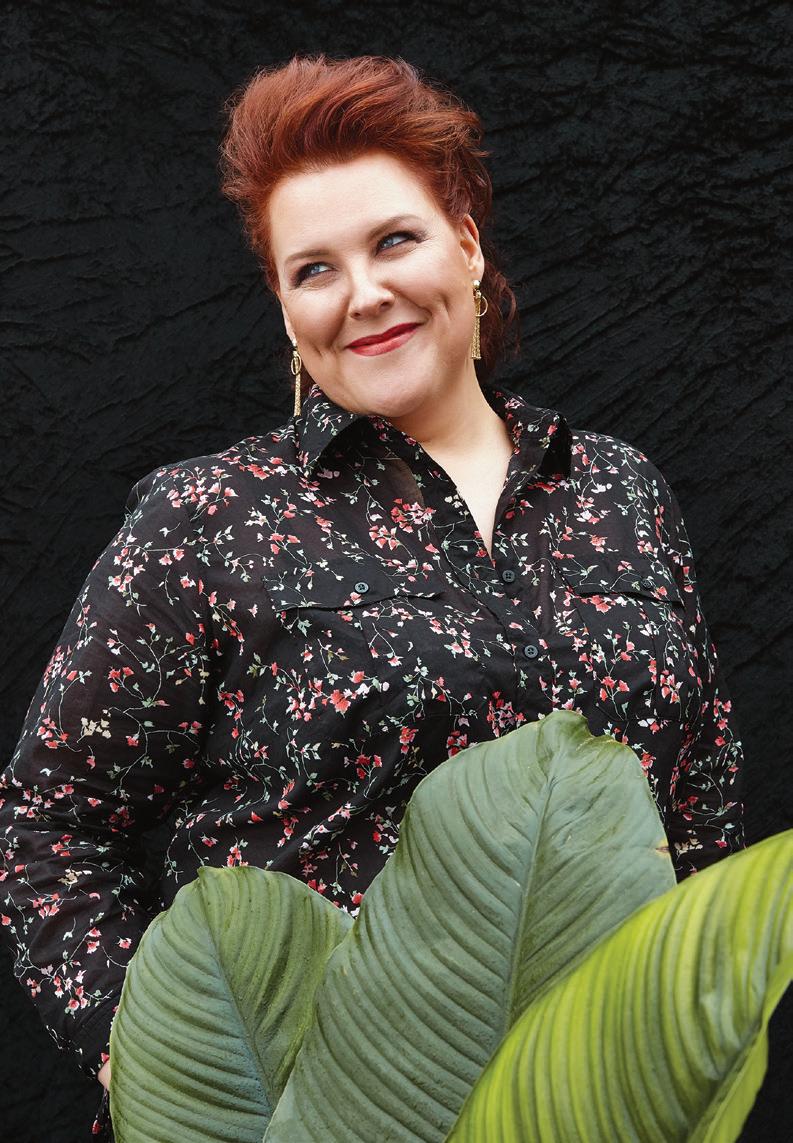
Upcoming projects include Il Trovatore (Azucena) in Montreal, Falstaff (Mrs. Quigley) at the Metropolitan Opera, Un Ballo in maschera (Ulrica) and Les Troyens (Cassandre) in Munich, the title role in Carmen at Chorégies d’Orange, and she will be part of a new Ring des Nibelungen in Brussels and in Paris.
Ms. Lemieux is a Knight of the National Order of Quebec, Compagne des Arts et des Lettres du Québec, and a member of the Order of Canada and of the Order of the Pleiades. She also has a Doctor Honoris Causa delivered by the Université du Québec à Chicoutimi.
PHOTO
THE CLEVELAND ORCHESTRA | 21clevelandorchestra.com
BY MARTIN TREMBLAY © WARNER CLASSICS
Lisa Wong, Director of Choruses
frances p. and chester c. bolton chair
In addition to her duties at Severance, she is a faculty member at the College of Wooster, where she co-chairs the Music Department, conducts the Wooster Chorus, and teaches courses in conduct ing and music education. Choirs under her direction have performed at the Central Division conference of the American Choral Directors Association and several times for the state conference of the Ohio Music Education Association. An advocate for the music of underrepresented composers, Ms. Wong serves as the Repertoire and Resource Chair for World Music and Cultures for the Ohio Choral Directors Association. Her previous academic posts include positions in public and private schools in New York, Pennsylvania, and Indiana.
LISA WONG WAS APPOINTED director of choruses for The Cleveland Orchestra in May 2018 after serving as acting director throughout the 2017/18 season. She joined the choral staff of The Cleveland Orchestra as assistant director of choruses at the start of the 2010/11 season, helping to prepare the Cleveland Orchestra Chorus and Blossom Festival Chorus for performances each year. In 2012, she took on added responsibilities as director of the Cleveland Orchestra Youth Chorus.
Active as a clinician, guest conductor, and adjudicator, she serves as a music panelist for the National Endowment for the Arts. Recent international accolades have included work at Kenyatta University in Nairobi, Kenya, as a part of Tunaweza Kimuziki, and as a conductor for “Conducting 21C: Musical Leadership for a New Century” in Stockholm, Sweden. Ms. Wong holds a bachelor of science degree in music education from West Chester University, as well as master of music and doctor of music degrees in choral conducting from Indiana University.
 PHOTO BY
PHOTO BY
22 | 2022/2023 SEASON
ROGER MASTROIANNI THE CLEVELAND ORCHESTRA CHORUS
Cleveland Orchestra Chorus
Lisa Wong, DIRECTOR
Daniel J. Singer, ASSISTANT DIRECTOR
Daniel Overly, COLLABORATIVE PIANIST
SOPRANOS
Amy Foster Babinski
Claudia Barriga
Yu-Ching Ruby Chen
Amanda Cobes
Sasha Desberg
Caitlin DiFranco
Emily Engle
Molly Falasco
Lisa Fedorovich
Nicole Futoran
Samantha Garner Jennifer Gilles
Ayesha Gonzales
Sarah Gould
Julia Halamek
Rebecca S. Hall Sarah Henley
Lisa Hrusovsky
Amber Jackson Shannon R. Jakubczak
Katie Kitchen EvaCecilia Koh Molly Lukens
Clare Mitchell S. Mikhaila Noble-Pace
Jennifer Heinert O’Leary
Katie Paskey
Victoria Peacock Elizabeth Phillips Grace Prentice
Jylian Purtee Cara Rovella
Katie Schick
Ellie Smith
Megan Tettau
Sharilee Walker Kate Macy Walters Adeleine Whitten
ALTOS
Emily Austin
Debbie Bates
Riley Beistel
Brooke Emmel
Karen S. Hunt Sarah Hutchins
Kate Klonowski Kristi Krueger Elise Leitzel
Cathy Lesser Mansfield Danielle S. McDonald Karla McMullen
Holly Miller
Peggy A. Norman Dawn Ostrowski Ellie Petro Andrea Pintabona Victoria Rasnick Kayla Reaves
Faith Roberts
Alanna M. Shadrake
Ina Stanek-Michaelis
Melanie Tabak
Rachel Thibo
Kristen Tobey Joanna Tomassoni Martha Cochran Truby
Laure Wasserbauer Caroline Willoughby
Leah Wilson
Jennifer R. Woda Debra Yasinow Lynne Leutenberg Yulish
TENORS Bruno Bush Rong Chen Richard Hall Daniel M. Katz Peter Kvidera Adam Landry Tod Lawrence David McCallum James C. Pintner Matthew Rizer Ted Rodenborn Nathan A. Russell John Sabol Andrew Schoenhofer Emerson Slicer Andrew Stamp William Venable Allen White
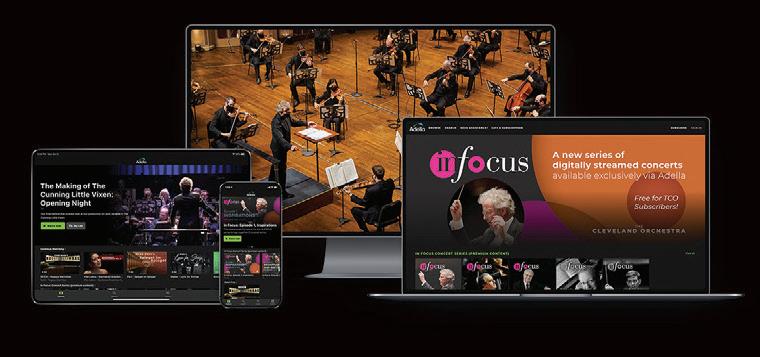
Peter Wright
BASSES
Craig Astler Jack Blazey
Ronnie Boscarello
Sean Michael Cahill Peter B. Clausen
Nick Connavino
Kyle Crowley
Christopher Dewald
Jeffrey Duber
Stuart Englehart
Brian Fancher
Andrew Fowler
Mark Hermann
Seth Hobi
Kurtis B. Hoffman
Robert L. Jenkins III
James Johnston
Kevin Kutz
Jason Levy Jacob J. Liptow
Tyler Mason
Robert Mitchell Tremaine Oatman Francisco Prado Brandon Randall Robert G. Seaman
Charlie Smrekar Devon Steve Charles Tobias Matt Turell
Jill Harbaugh MANAGER OF CHORUSES
Lisa Fedorovich CHAIR, CLEVELAND ORCHESTRA CHORUS OPERATING COMMITTEE
Adella, our streaming service and app, features on-demand portraits, music showcases, behind-the-scenes footage and our flagship In Focus premium concert series, which launches Season 3 on October 7 THE CLEVELAND ORCHESTRA ANYTIME & ANYWHERE Visit Adella.live to start your free trial.
THE

NOW IN ITS SECOND CENTURY , The Cleveland Orchestra, under the leadership of music director Franz Welser-Möst since 2002, is one of the most sought-after performing ensem bles in the world. Year after year, the ensemble exemplifies extraordinary artistic excellence, creative programming, and community engagement. The New York Times has called Cleveland “the best in America” for its virtuosity, elegance of sound, variety of color, and chamber-like musical cohesion.
Founded by Adella Prentiss Hughes, the Orchestra performed its inaugural concert in December 1918. By the middle of the century, decades of growth and sustained support had turned it into one of the most admired globally.
The past decade has seen an increasing number of young people attending concerts, bringing fresh attention to The Cleveland Orchestra’s legendary sound and committed programming. More recently, the Orchestra launched several bold digital projects, including the streaming broadcast series In Focus, the podcast On a Personal Note, and its own recording label, a new chapter in the Orchestra’s long and distin guished recording and broadcast history. Together, they have captured the Orchestra’s unique artistry and the musical achievements of the Welser-Möst and Cleveland Orchestra partnership.
The 2022/23 season marks Franz Welser-Möst’s 21st year as music director, a period in which The Cleveland Orchestra earned unprecedented acclaim around the world, including a series of residencies at the Musikverein in Vienna, the first of its kind by an American orchestra, and a number of acclaimed opera presentations.
Since 1918, seven music directors — Nikolai Sokoloff, Artur Rodziński, Erich Leinsdorf, George Szell, Lorin Maazel, Christoph von Dohnányi, and Franz Welser-Möst — have guided and shaped the ensemble’s growth and sound. Through concerts at home and on tour, broadcasts, and a catalog of acclaimed recordings, The Cleveland Orchestra is heard today by a growing group of fans around the world.
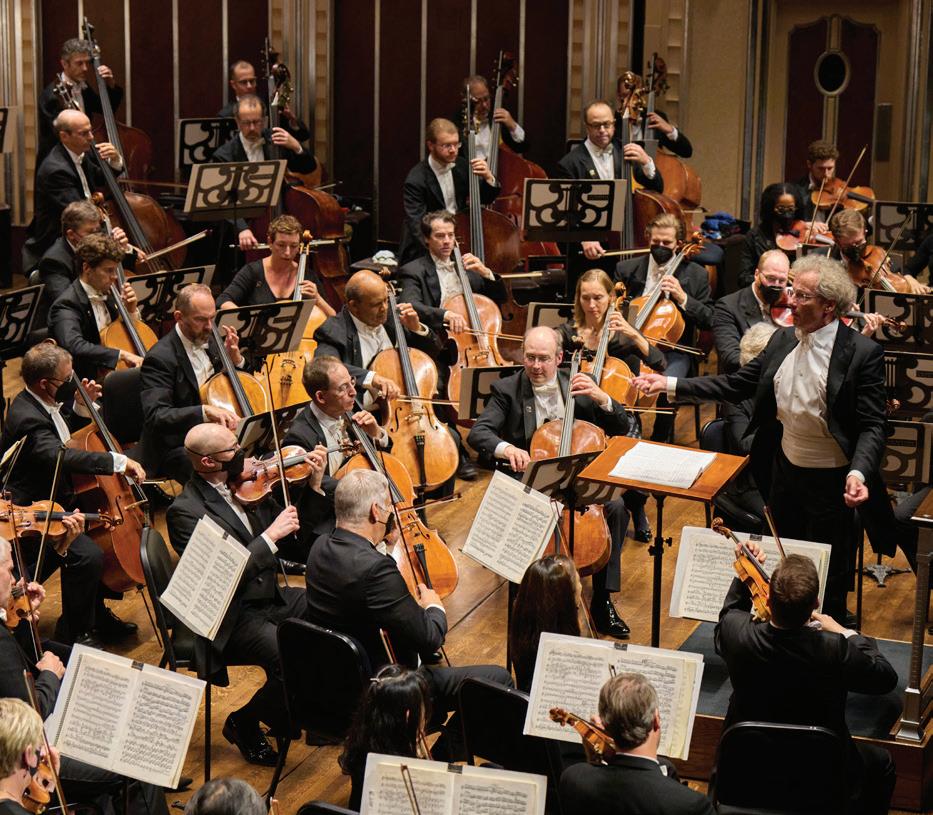 PHOTO
PHOTO
24 | 2022/2023 SEASON
CLEVELAND ORCHESTRA
@ClevelandOrchestra @clevelandorchestra@CleveOrchestra@Cleveorch
BY ROGER MASTROIANNI





























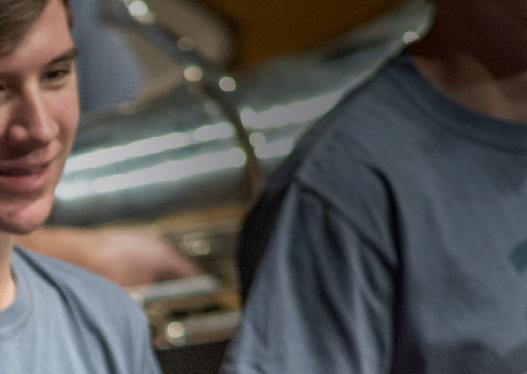


Contemporary Youth Orchestra ROB E R T MULLE R I F Y O U’ RE L O OK ING T O create something magical. E X P L O R E O N L I NEClevelandArtsEvents com connects you to the region’s vibrant arts and culture scene With just a few clicks, discover hundreds of events made possible in part with public funding from Cuyahoga Arts & Culture
THE CLEVELAND ORCHESTRA
 Franz Welser-Möst, MUSIC DIRECTOR Kelvin Smith Family Chair
Franz Welser-Möst, MUSIC DIRECTOR Kelvin Smith Family Chair
FIRST VIOLINS
Peter Otto
FIRST ASSOCIATE CONCERTMASTER
Virginia M. Lindseth, PhD, Chair
Jung-Min Amy Lee ASSOCIATE CONCERTMASTER
Gretchen D. and Ward Smith Chair
Jessica Lee ASSISTANT CONCERTMASTER Clara G. and George P. Bickford Chair
Stephen Tavani ASSISTANT CONCERTMASTER
Wei-Fang Gu Drs. Paul M. and Renate H. Duchesneau Chair
Kim Gomez Elizabeth and Leslie Kondorossy Chair Chul-In Park
Harriet T. and David L. Simon Chair
Miho Hashizume Theodore Rautenberg Chair
Jeanne Preucil Rose
Larry J.B. and Barbara S. Robinson Chair
Alicia Koelz
Oswald and Phyllis Lerner Gilroy Chair
Yu Yuan Patty and John Collinson Chair
Isabel Trautwein Trevor and Jennie Jones Chair
Katherine Bormann Analisé Denise Kukelhan Gladys B. Goetz Chair Zhan Shu
SECOND VIOLINS
Stephen Rose*
Alfred M. and Clara T. Rankin Chair
Eli Matthews1
Patricia M. Kozerefski and Richard J. Bogomolny Chair
Sonja Braaten Molloy Carolyn Gadiel Warner
Elayna Duitman Ioana Missits
Jeffrey Zehngut Vladimir Deninzon Sae Shiragami
Scott Weber
Kathleen Collins
Beth Woodside Emma Shook Dr. Jeanette Grasselli Brown and Dr. Glenn R. Brown Chair
Yun-Ting Lee
Jiah Chung Chapdelaine
VIOLAS
Wesley Collins* Chaillé H. and Richard B. Tullis Chair
Lynne Ramsey1 Charles M. and Janet G. Kimball Chair
Stanley Konopka2
Mark Jackobs Jean Wall Bennett Chair
Lisa Boyko
Richard and Nancy Sneed Chair
Richard Waugh Lembi Veskimets
The Morgan Sisters Chair
Eliesha Nelson Joanna Patterson Zakany
William Bender Gareth Zehngut
CELLOS
Mark Kosower* Louis D. Beaumont Chair
Richard Weiss1 The GAR Foundation Chair
Charles Bernard2
Helen Weil Ross Chair
Bryan Dumm Muriel and Noah Butkin Chair
Tanya Ell Thomas J. and Judith Fay Gruber Chair
Ralph Curry Brian Thornton William P. Blair III Chair David Alan Harrell Martha Baldwin Dane Johansen Paul Kushious
BASSES
Maximilian Dimoff* Clarence T. Reinberger Chair
Derek Zadinsky2 Mark Atherton
Thomas Sperl Henry Peyrebrune Charles Barr Memorial Chair
Charles Carleton Scott Dixon Charles Paul HARP
Trina Struble* Alice Chalifoux Chair
FLUTES
Joshua Smith* Elizabeth M. and William C. Treuhaft Chair
Saeran St. Christopher Jessica Sindell2 Austin B. and Ellen W. Chinn Chair Mary Kay Fink
PICCOLO
Mary Kay Fink Anne M. and M. Roger Clapp Chair
OBOES
Frank Rosenwein* Edith S. Taplin Chair
Corbin Stair Sharon and Yoash Wiener Chair
Jeffrey Rathbun2 Everett D. and Eugenia S. McCurdy Chair
Robert Walters
ENGLISH HORN
Robert Walters Samuel C. and Bernette K. Jaffe Chair
CLARINETS
Afendi Yusuf* Robert Marcellus Chair
Robert Woolfrey Victoire G. and Alfred M. Rankin, Jr. Chair
Daniel McKelway2 Robert R. and Vilma L. Kohn Chair Amy Zoloto
E-FLAT CLARINET
Daniel McKelway Stanley L. and Eloise M. Morgan Chair
BASS CLARINET
Amy Zoloto
Myrna and James Spira Chair
BASSOONS
John Clouser*
Louise Harkness Ingalls Chair
Gareth Thomas
Barrick Stees2
Sandra L. Haslinger Chair
Jonathan Sherwin
CONTRABASSOON Jonathan Sherwin
HORNS
Nathaniel Silberschlag* George Szell Memorial Chair
26 | 2022/2023 SEASON
Michael Mayhew§ Knight Foundation Chair Jesse McCormick Robert B. Benyo Chair Hans Clebsch
Richard King
TRUMPETS
Michael Sachs* Robert and Eunice Podis Weiskopf Chair
Jack Sutte
Lyle Steelman2 James P. and Dolores D. Storer Chair
Michael Miller
CORNETS
Michael Sachs* Mary Elizabeth and G. Robert Klein Chair
Michael Miller
TROMBONES
Brian Wendel* Gilbert W. and Louise I. Humphrey Chair
Richard Stout Alexander and Marianna C. McAfee Chair Shachar Israel2
EUPHONIUM & BASS TRUMPET
Richard Stout
TUBA
Yasuhito Sugiyama* Nathalie C. Spence and Nathalie S. Boswell Chair
TIMPANI
Paul Yancich* Otto G. and Corinne T. Voss Chair
PERCUSSION
Marc Damoulakis* Margaret Allen Ireland Chair
Donald Miller
Thomas Sherwood
KEYBOARD INSTRUMENTS
Carolyn Gadiel Warner Marjory and Marc L. Swartzbaugh Chair
LIBRARIANS
Michael Ferraguto Joe and Marlene Toot Chair
Donald Miller
ENDOWED CHAIRS
CURRENTLY UNOCCUPIED
Elizabeth Ring and William Gwinn Mather Chair Blossom-Lee Chair
Paul and Lucille Jones Chair
James and Donna Reid Chair
Mary E. and F. Joseph Callahan Chair
Sunshine Chair
Mr. and Mrs. Richard K. Smucker Chair
Rudolf Serkin Chair
CONDUCTORS
Christoph von Dohnányi MUSIC DIRECTOR LAUREATE
Daniel Reith ASSISTANT CONDUCTOR
Sidney and Doris Dworkin Chair
Lisa Wong
DIRECTOR OF CHORUSES
Frances P. and Chester C. Bolton Chair
* Principal § Associate Principal 1 First Assistant Principal 2 Assistant Principal
This roster lists full-time members of The Cleveland Orchestra. The number and seating of musicians onstage varies depending on the piece being performed. Seating within the string sections rotates on a periodic basis.
 PHOTO BY ROGER
PHOTO BY ROGER
THE CLEVELAND ORCHESTRA | 27clevelandorchestra.com
MASTROIANNI
What do world-class musicians, a globally renowned conductor, and the acoustic and architectural magnificence of Severance have in common? You. The audience we play for, and are simply not the same without. Your unbridled enthusiasm inspires us all to reach the greatest of heights in every performance. We invite you to once again be part of the wonder that is The Cleveland Orchestra: live and in person. All because of you.




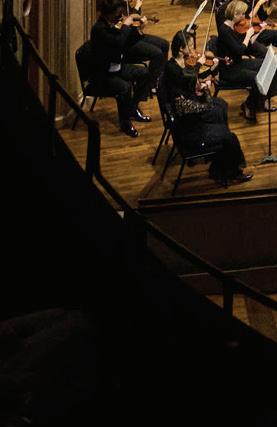

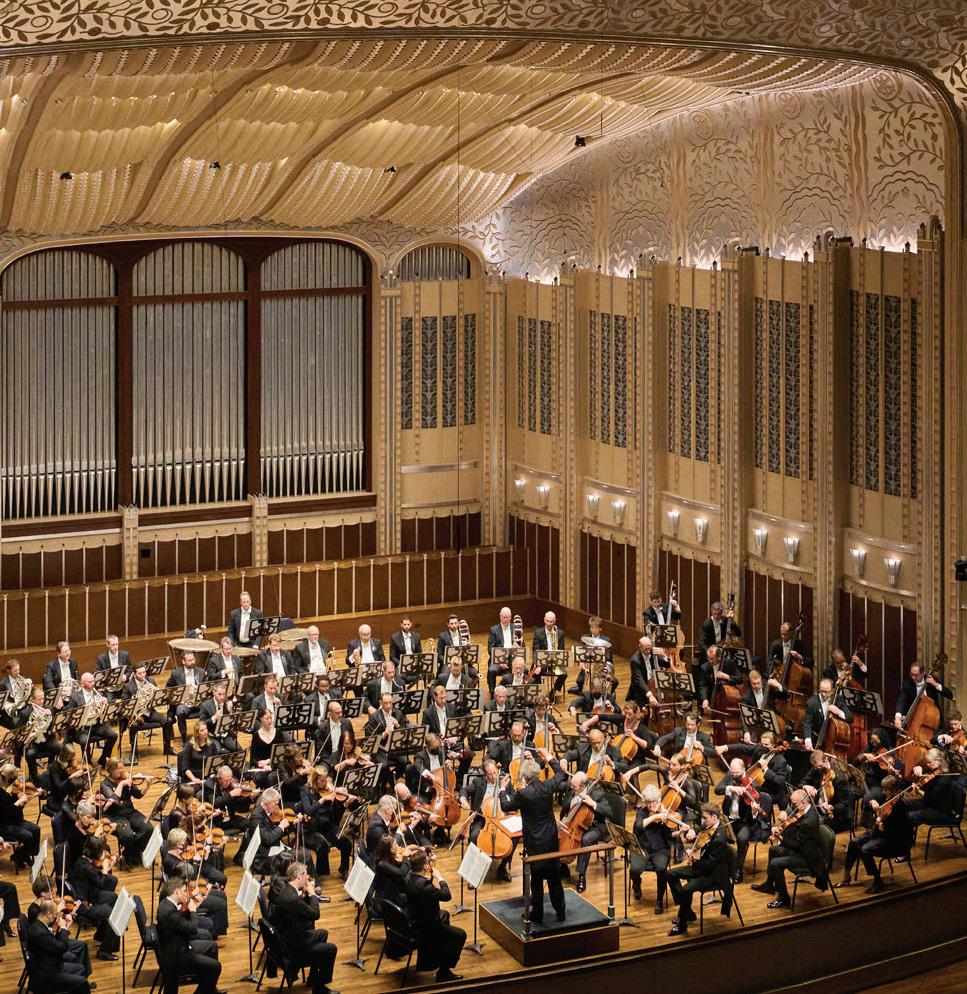

Please Join us!
SUBSCRIBERS ARE VITAL SUPPORTERS OF THE CLEVELAND ORCHESTRA
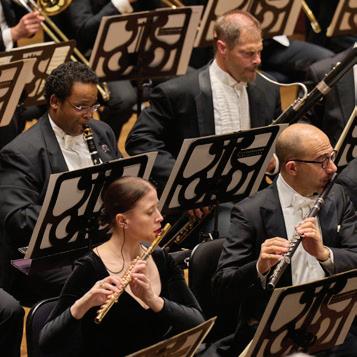
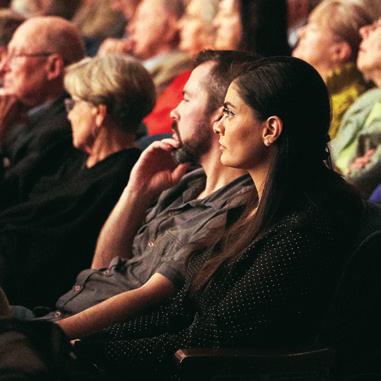
Free and easy ticket exchanges
The opportunity to purchase advance parking
10% off at The Cleveland Orchestra Store
Advance notice on concert announcements & offers
Free subscription to Spotlight magazine
exclusive benefits throughout the season.
Free access to In Focus, our digital concert series, with behind-the-scenes interviews and features
Free access to Adella Premium streaming service & app Money-back guarantee
Premier 2Create YourOwn 3
1
The best seats and the best savings.
Curated packages for as few as three concerts starting at just $66.
Enjoy each concert from the same seats — yours to renew year after year — and it’s our best value at savings of up to 35% off single-ticket prices. If your schedule changes, take advantage of FREE and easy ticket exchanges. Select a concert series and seating preference that fits your schedule and budget.
See more concerts you want? Save 20% on any additional classical concert tickets.

Your schedule and your choices.
Save up to 25% off singleticket prices when you choose 4 concerts or more.
Build a Create Your Own series that perfectly fits your concertgoing lifestyle. Simply choose your favorite concerts, select your dates, then reserve your seats.
Member’s
C lubThe most flexibility.
Your all-access pass to concerts at Severance Music Center and Blossom Music Festival.
For a monthly fee of $35, you can purchase tickets for just $10. When you buy as few as five tickets, you save over singleticket prices.
Choose from over 100 concerts a year!
subscriptions@clevelandorchestra.com | 216-231-1111 clevelandorchestra.com/subscribe
SUBSCRIBE TODAY! Make your choice from three great subscription options and enjoy
CALENDAR
Don’t miss a moment
FALL
SEP 29, 30
MAHLER’S RESURRECTION
Franz Welser-Möst, conductor Lauren Snouffer, soprano Marie-Nicole Lemieux, contralto Cleveland Orchestra Chorus
MAHLER Symphony No. 2 (“Resurrection”)
OCT 7, 8
SAINT-SAËNS
ORGAN SYMPHONY
Thierry Fischer, conductor Vilde Frang, violin BOULEZ Notations
STRAVINSKY Violin Concerto
SAINT-SAËNS Symphony No. 3 (“Organ”)
OCT 13, 14, 15, 16
BEETHOVEN’S EROICA
Nikolaj Szeps-Znaider, conductor Mark Kosower, cello*
AL-ZAND Lamentation on The Disasters of War
BLOCH Schelomo, Hebraic Rhapsody for Cello and Orchestra*
BEETHOVEN Symphony No. 3 (“Eroica”)
* not part of Friday Matinee concert
OCT 20, 22
AN ALPINE SYMPHONY
Daniel Harding, conductor
Antoine Tamestit, viola
WIDMANN Viola Concerto STRAUSS Eine Alpensinfonie
OCT 27, 28, 29
GERSTEIN PLAYS
SCHUMANN
Edward Gardner, conductor Kirill Gerstein, piano
BENJAMIN Ringed by a Flat Horizon SCHUMANN Piano Concerto DVOŘÁK Symphony No. 7
NOV 17, 18, 19
EL NIÑO
John Adams, conductor Lauren Snouffer, soprano Josefina Maldonado, mezzo-soprano Davóne Tines, bass-baritone
Daniel Bubeck, countertenor Brian Cummings, countertenor Nathan Medley, countertenor Cleveland Orchestra Chorus Cleveland Orchestra Children’s Chorus
ADAMS El Niño
NOV 25, 26, 27
THE FIREBIRD
Thomas Søndergård, conductor Stefan Jackiw, violin
BRITTEN Violin Concerto No. 1
STRAVINSKY The Firebird (complete ballet)
DEC 1, 2, 3
ELGAR AND WALTON
Vasily Petrenko, conductor Behzod Abduraimov, piano*
ELGAR Cockaigne (“In London Town”)
PROKOFIEV Piano Concerto No. 2*
WALTON Symphony No. 1
* not part of Friday Matinee concert
WINTER
JAN 5, 7
NIELSEN AND HAYDN
Alan Gilbert, conductor Paul Yancich, timpani Liv Redpath, soprano
Justin Austin, baritone
OLIVERIO Timpani Concerto
HAYDN Symphony No. 90
NIELSEN Symphony No. 3 (“Sinfonia espansiva”)
JAN 12, 13, 14
WELSER-MÖST
CONDUCTS SCHUBERT
Franz Welser-Möst, conductor Joélle Harvey, soprano
Daryl Freedman, mezzo-soprano
Julian Prégardien, tenor
Martin Mitterrutzner, tenor
Dashon Burton, bass-baritone Cleveland Orchestra Chorus
BERG Lyric Suite*
SCHUBERT Symphony No. 8* (“Unfinished”)
SCHUBERT Mass No. 6
* The movements of the Lyric Suite will be performed in rotation with Symphony No. 8
FEB 2, 3, 4, 5
BOLÉRO
Klaus Mäkelä, conductor Truls Mørk, cello
SALONEN Cello Concerto DEBUSSY Images
RAVEL Boléro
clevelandorchestra.com
of unforgettable music!
FEB 9, 11
MAHLER’S FIFTH
Klaus Mäkelä, conductor CHIN SPIRA—Concerto for Orchestra
MAHLER Symphony No. 5
FEB 16, 17, 18
BEETHOVEN’S SEVENTH
Herbert Blomstedt, conductor Emanuel Ax, piano
MOZART Piano Concerto No. 18 (“Paradis”)
BEETHOVEN Symphony No. 7
FEB 23, 24, 25
MOZART AND STRAUSS
Franz Welser-Möst, conductor
MOZART Divertimento No. 2*
SCHOENBERG Variations for Orchestra
STRAUSS Ein Heldenleben * not part of Friday Matinee concert
MAR 2, 3, 4, 5
PICTURES AT AN EXHIBITION
Franz Welser-Möst, conductor Víkingur Ólafsson, piano
FARRENC Symphony No. 3
RAVEL Piano Concerto in G major MUSSORGSKY/RAVEL Pictures at an Exhibition
MAR 9, 10, 11, 12
MOZART’S REQUIEM
Franz Welser-Möst, conductor Christoph Sietzen, percussion
Siobhan Stagg, soprano
Avery Amereau, alto
Ben Bliss, tenor
Anthony Schneider, bass
Cleveland Orchestra Chorus
STAUD Concerto for Percussion
MOZART Requiem
SPRING
MAR 30, 31, & APR 1
INSPIRATION: THE TEMPEST
Thomas Adès, conductor Pekka Kuusisto, violin ADÈS Tempest Suite ADÈS Märchentänze
SIBELIUS Six Humoresques* SIBELIUS Prelude and Suite No. 1 from The Tempest*
* Certain selections will not be part of the Friday Matinee concert
APR 6, 7, 8
SHOSTAKOVICH’S FIFTH SYMPHONY
Rafael Payare, conductor Jean-Yves Thibaudet, piano
BERNSTEIN Symphony No. 2 (“The Age of Anxiety”)
SHOSTAKOVICH Symphony No. 5
APR 13, 15, 16
MAHLER’S TITAN
Michael Tilson Thomas, conductor Leif Ove Andsnes, piano
DEBUSSY Jeux, poème dansé DEBUSSY Fantaisie for Piano and Orchestra
MAHLER Symphony No. 1 (“Titan”)
APR 20, 21, 22, 23
ALL MOZART
Bernard Labadie, conductor Lucy Crowe, soprano
MOZART Overture to La clemenza di Tito MOZART “Giunse al fin il momento... Al desio di chi t’adora”
MOZART Ruhe Zanft from Zaide
MOZART Masonic Funeral Music
MOZART “Venga la morte... Non temer, amato bene”
MOZART Symphony No. 41 (“Jupiter”)
APR 27, 28, 29
MARSALIS AND NEW WORLD
Franz Welser-Möst, conductor Michael Sachs, trumpet MARTINŮ Symphony No. 2 MARSALIS Trumpet Concerto DVOŘÁK Symphony No. 9 (“From the New World”)
MAY 4, 6
WEILERSTEIN PLAYS
BARBER
Franz Welser-Möst, conductor Alisa Weilerstein, cello
LOGGINS-HULL Can You See? BARBER Cello Concerto PROKOFIEV Symphony No. 4
MAY 14, 17, 20
THE GIRL OF THE GOLDEN WEST
Franz Welser-Möst, conductor Tamara Wilson, soprano (Minnie) Eric Owens, bass (Jack Rance) Fabio Sartori, tenor (Dick Johnson) Cleveland Orchestra Chorus
PUCCINI La Fanciulla del West
(The Girl of the Golden West)
* Opera presentation, sung in Italian with projected supertitles
YOUR VISIT
HEALTH & SAFETY
The Cleveland Orchestra is committed to creating a comfortable, enjoyable, and safe environment for all guests at Severance Music Center. While mask and COVID-19 vaccination are recommended they are not required. Protocols are reviewed regularly with the assistance of our Cleveland Clinic partners; for up-to-date information, visit: clevelandorchestra. com/attend/health-safety
LATE SEATING
As a courtesy to the audience members and musicians in the hall, late-arriving patrons are asked to wait quietly until the first convenient break in the program. These seating breaks are at the discretion of the House Manager in consultation with the performing artists.
PAGERS, CELL PHONES & WRISTWATCH ALARMS
As a courtesy to others, please silence all devices prior to the start of the concert.
PHOTOGRAPHY, VIDEOGRAPHY & RECORDING
Audio recording, photography, and videography are prohibited during performances at Severance. Photographs can only be taken when the performance is not in progress.
HEARING AIDS & OTHER HEALTH-ASSISTIVE DEVICES
For the comfort of those around you, please reduce the volume on hearing aids and other devices that may produce a noise that would detract from the program. For Infrared Assistive-Listening Devices, please see the House Manager or Head Usher for more details.
IN THE EVENT OF AN EMERGENCY
Contact an usher or a member of house staff if you require medical assistance. Emergency exits are clearly marked throughout the building. Ushers and house staff will provide instructions in the event of an emergency.
AGE RESTRICTIONS
Regardless of age, each person must have a ticket and be able to sit quietly in a seat throughout the performance. Classical season subscription concerts are not recommended for children under the age of 8. However, there are several age-appropriate series designed specifically for children and youth, including Music Explorers (for 3 to 6 years old) and Family Concerts (for ages 7 and older).
The Cleveland Orchestra is grateful to the following organizations for their ongoing generous support of The Cleveland Orchestra: National Endowment for the Arts, the State of Ohio and Ohio Arts Council, and to the residents of Cuyahoga County through Cuyahoga Arts and Culture.
Cleveland
The Cleveland Orchestra is proud of its long-term partnership with Kent State University, made possible in part through generous funding from the State of Ohio.
The Cleveland Orchestra is proud to have its home, Severance Music Center, located on the campus of Case Western Reserve University, with whom it has along history of collaboration and partnership.
© 2022 The Cleveland Orchestra and the Musical Arts Association Program books for Cleveland Orchestra concerts are produced by The Cleveland Orchestra and are distributed free to attending audience members.
EDITOR
Amanda Angel Managing Editor of Content aangel@clevelandorchestra.com
DESIGN Elizabeth Eddins, eddinsdesign.com
ADVERTISING Live Publishing Company, 216-721-1800
32 | 2022/2023 SEASON
Download today for instant, secure, and paperless access to your concert tickets. For more information and direct links to download, visit: clevelandorchestra.com/ticketwallet Or scan the code with your smartphone camera to download the app for iPhone or Android. Available for iOS and Android on Google Play and at the Apple App Store.
clevelandorchestra.com
Orchestra performances are broadcast as part of regular programming on ideastream/WCLV Classical 104.9 FM, Saturdays at 8 p.m. and Sundays at 4 p.m. FREE MOBILE APP TICKET WALLET
Beyond impressive.
See this extraordinary collection of more than 100 masterworks—the largest gift of art to the museum in more than 60 years—together for the first and only time.
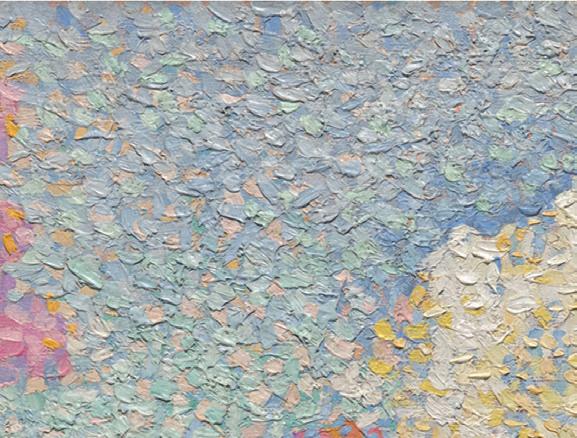
Open Now | Tickets at cma.org | CMA Members FREE
The Cleveland Museum of Art is funded in part by residents of Cuyahoga County through a public grant from Cuyahoga Arts & Culture. This exhibition was supported in part by the Ohio Arts Council, which receives support from the State of Ohio and the National Endowment for the Arts.



Henri-Edmond Cross (French, 1856–1910). The Pink Cloud, c.











Nancy F. and Joseph P. Keithley Collection Gift,
 PHOTO
PHOTO
CREDITS XXXX
IMPRESSIONISM to MODERNISM the Keithley Collection
1896. Oil on canvas; 54.6 x 61 cm.
2020.106
A SYMPHONY OF

We believe that all Cleveland youth should have access to high-quality arts education. Through the generosity of our donors, we are investing to scale up neighborhoodbased programs that now serve 3,000 youth year-round in music, dance, theater, photography, literary arts and curatorial mastery. That’s a symphony of success. Find your passion, and partner with the Cleveland Foundation to make your greatest charitable impact. (877) 554-5054
www.ClevelandFoundation.org

Rainey Institute El Sistema Orchestra
Success
